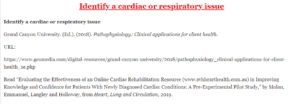Identify a cardiac or respiratory issue
Identify a cardiac or respiratory issue
Identify a cardiac or respiratory issue 
Grand Canyon University. (Ed.). (2018). Pathophysiology: Clinical applications for client health.
URL:
https://www.gcumedia.com/digital-resources/grand-canyon-university/2018/pathophysiology_clinical-applications-for-client-health_1e.php
Read “Evaluating the Effectiveness of an Online Cardiac Rehabilitation Resource (www.svhhearthealth.com.au) in Improving Knowledge and Confidence for Patients With Newly Diagnosed Cardiac Conditions: A Pre-Experimental Pilot Study,” by Molan, Emmanuel, Langley and Holloway, from Heart, Lung and Circulation, 2019.
URL:
https://www-sciencedirect-com.lopes.idm.oclc.org/science/article/pii/S144395061830129X
Read “A Nursing Care of Patients After Cardiac Arrest in the Course of Myocardial Infarction,” by Kaminska and Krzeminska, from Journal of Education, Health and Sport (2018).
URL:
https://doaj.org/article/39ac6a139c46478997596aa30cf17811?
| Topic 1 DQ 1 (250 words) |
Identify a cardiac or respiratory issue and outline the key steps necessary to include for prevention and health promotion.
| Topic 1 DQ 2(250 words) |
Discuss what resources are often necessary for nonacute care for cardiorespiratory issues. Explain how they support patient independence and decrease readmission.
Helpful Resources
Read “Advanced CT for Diagnosis of Seizure-Related Stroke Mimics,” by Austein, Huhndorf, Meyne, Laufs, Jansen, and Lindner, from European Radiology (2018).
URL:
https://lopes.idm.oclc.org/login?url=https://search.ebscohost.com/login.aspx?direct=true&db=ccm&AN=128864698&site=eds-live&scope=site
Read “Long-Term Effects on Survival After a 1-Year Multifactorial Vascular Risk Factor Intervention After Stroke or TIA: Secondary Analysis of a Randomized Controlled Trial, a 7-Year Follow-Up Study,” by Hagberg et al., from Vascular Health and Risk Management (2019).
URL:
https://lopes.idm.oclc.org/login?url=https://search.ebscohost.com/login.aspx?direct=true&db=ccm&AN=135138889&site=eds-live&scope=site
| Topic 2 DQ 1(250 words) |
Identify a common perceptual, neurological, or cognitive issue and discuss contributing factors. Outline steps for prevention or health promotion for the patient and family.
| Topic 2 DQ 2(250 words) |
Discuss characteristic findings for a stroke and how it affects the lives of patients and their families. Discuss the nurse’s role in supporting the patient’s psychological and emotional needs. Provide an example.
Use the following coupon code :
premiernursingpapers


